
Research
Keywords
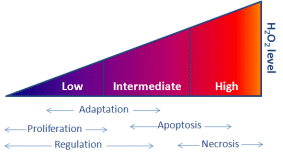
Our group is interested in redox regulation and signalling by H2O2, the major reactive oxygen species (ROS) produced endogenously in cells. The studies that are being carried out by our group aim at elucidate:
- The role of H2O2 in the regulation of lipid metabolism and plasma membrane dynamics in yeast and human cell lines;
- how low levels of H2O2, modulate gene expression and transcription factors such as NF-kB, Nrf2 and Opi1p in human cell lines and yeast;
- how H2O2 affects the human centrosomal protein TBCCD1;
- H2O2 role in endothelial function as a modulator of histone post-translational modifications and angiogensis;
Whenever possible the team applies to human health the know-how obtained in fundamental research.
Research themes
hydrogen peroxide-dependent regulation of lipid metabolism and plasma membrane dynamics in the yeast Saccharomyces cerevisiae
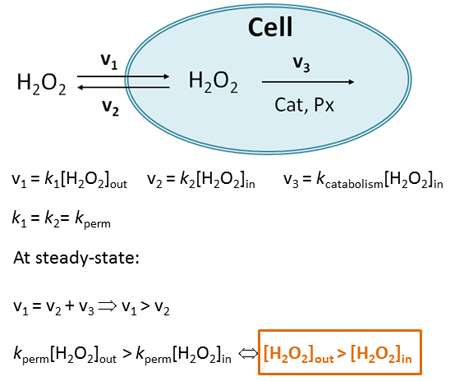 Hydrogen peroxide is a small and neutral molecule and thus highly diffusible through biomembranes.
Recent work by our group has shown that hydrogen peroxide diffusion through the plasma membrane into human cell lines and S. cerevisiae rate-limits consumption of extracellular hydrogen peroxide. This finding contradicts the widely believed concept that H2O2
freely diffuses through biomembranes, and implies that concentration gradients of hydrogen peroxide are formed across membranes (Marinho et al, 2013).
Hydrogen peroxide is a small and neutral molecule and thus highly diffusible through biomembranes.
Recent work by our group has shown that hydrogen peroxide diffusion through the plasma membrane into human cell lines and S. cerevisiae rate-limits consumption of extracellular hydrogen peroxide. This finding contradicts the widely believed concept that H2O2
freely diffuses through biomembranes, and implies that concentration gradients of hydrogen peroxide are formed across membranes (Marinho et al, 2013).
Cells exposed to sub-lethal doses of hydrogen peroxide (e.g. 150 µM steady-state hydrogen peroxide for 15-90 min) can adapt to additional exposure to lethal doses (e.g. 700 µM steady-state hydrogen peroxide for 60 min), by acquiring resistance. This is reflected in a higher survival rate of cells when further exposed to lethal concentrations of the same agent. In S. cerevisiae, the adaptive response to oxidative stress has been mainly focused in the increased expression of the antioxidant enzymes catalyzing hydrogen peroxide elimination or on systems responsible for repairing hydrogen peroxide-induced damage. Recently, our group has shown that during adaptation of S. cerevisiae cells to hydrogen peroxide there is a decrease of the permeability of the plasma membrane to hydrogen peroxide (Branco et al., 2004). In fact, in S. cerevisiae cells the permeability of the plasma membrane towards hydrogen peroxide is under active regulation both during the response to oxidative stress (Branco et al., 2004) and during the life cycle (Sousa-Lopes et al., 2004).
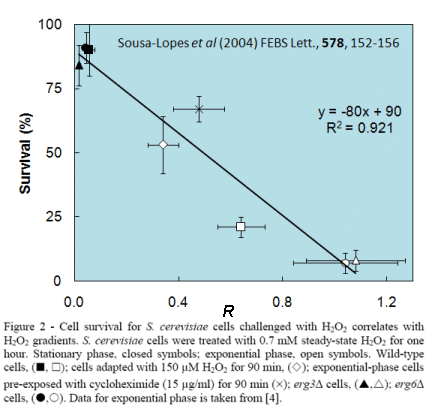
This lower plasma membrane permeability, together with the increase in intracellular H2O2-removing antioxidant enzymes that occurs in adaptation, increases the hydrogen peroxide gradient between the exterior and the interior of the cell. Thus, S. cerevisiae cells protection against external hydrogen peroxide increases after adaptation to this agent, because for the same extracellular H2O2 concentration there is a lower hydrogen peroxide concentration inside the cells.
The main focus of this line of research is therefore to understand the molecular mechanisms by which hydrogen peroxide regulates the plasma membrane. Results showed that during adaptation to hydrogen peroxide the plasma membrane lipid and protein profile changes and there is a reorganization of membrane microdomains, the, so called, lipid rafts (Pedroso et al., 2009, 2012).
Fatty acid synthase (Fas) plays a key role during the cellular response of Saccharomyces cerevisiae to hydrogen peroxide (Matias et al., 2007): (1) adaptation was associated with a decrease in both Fas expression and activity; (2) more importantly, decreasing Fas activity by 50% through deletion of one of the FAS alleles increased the resistance to lethal doses of H2O2. The fact that the plasma membrane of fas1D cells has higher levels of very-long-chain fatty acids suggests that alterations in the plasma membrane composition are involved in this resistance caused by lower Fas activity.
Collaborations:
Prof. Enrique Herrero (Molecular Biology of Yeasts Group, Faculty of Medicine, University of Lleida, Spain)
Dr. Rodrigo de Almeida - CQB, Molecular and Neural Biophysics Group;
Dr. Rui Malhó (BIOFIG-FCUL).
Role of peroxiredoxins in hydrogen peroxide metabolism and signalling in Yeast
In the last years it has been established that of redox regulation has a pivotal role in health and disease. However, important questions remain unanswered (Marinho et al, 2014), e.g. What makes a good H2O2 sensor? What are the common chemical and kinetic principles that govern H2O2 signaling? In these studies we aim at understanding H2O2-dependent signalling and the role of peroxiredoxins in redox-signalling relay..
Modulation of gene expression by hydrogen peroxide
The transcription factor NF-kB is a dimer consisting mainly of the proteins p65 and p50 which are present in the cytosol linked to an inhibitory protein IkB. Several compounds have the ability of activating this pathway by phosphorylation of IkB followed by its degradation through the proteasome. This allows Nf-kB translocation into the nucleus. NF-kB is a key regulator of the inflammatory process, innate and adaptive immunity.
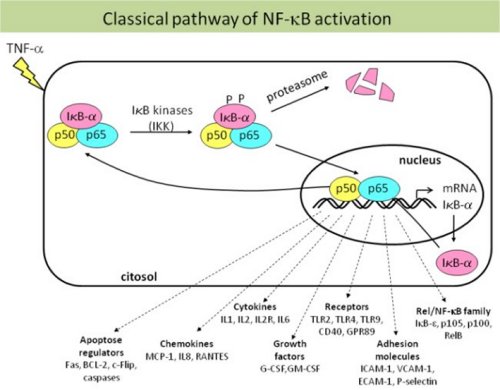
Several evidences suggest that hydrogen peroxide is implicated in the regulation of NF-kB. However, there is no consensus regarding the role played by H2O2 since both inhibitory and stimulatory effects have been reported. We hypothesized that these contradictory data are partly due to the methodology used to expose cells to H2O2. Usually, H2O2 is added at the beginning of the experiment - bolus addition - in high concentrations of H2O2 needed because of its rapid consumption by cells. Therefore the real [H2O2] that is exerting the effects is not known and the high initial dose masks a signaling role for H2O2 and often causes elevated oxidative damages. We have revisited the study of the role of H2O2 in NF-kB activation in human cell lines By using a different methodology - the steady-state (s.s.) titration whereby the use of glucose oxidase allows cells to be exposed to constant, lower and nearer to the physiological H2O2 concentrations - we have been able to prove that H2O2 is not an inducer of NF-kB activation per se but acts as a modulator of NF-kB activation induced by cytokines such as TNF-alfa. We propose that H2O2 has a fine-tuning regulatory role, comprising both a proinflammatory control loop that increases pathogen removal and an anti-inflammatory control loop, which avoids an exacerbated harmful inflammatory response.
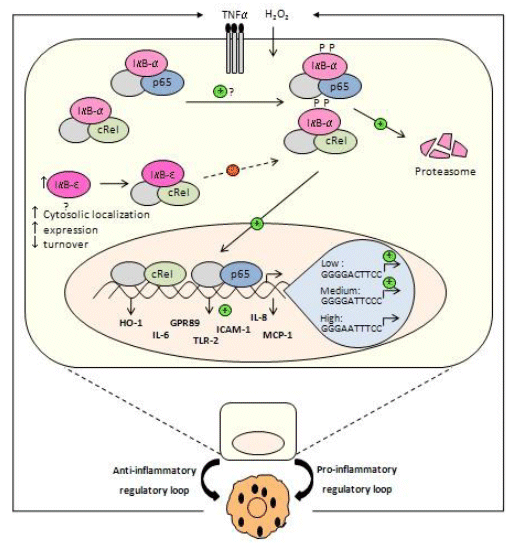
Nuclear factor erythroid-2-related factor 2 (NRF2) is a transcription factor of the leucine zipper family, and KEAP1 (Kelch-like ECH-associated protein 1) is its specific repressor, responsible for NRF2 sequestration in the cytoplasm as well as for its proteosomal degradation pathway. These two proteins mediate cellular response to oxidative stress and to electrophilic xenobiotics. We performed studies on the role of H2O2 in NRF2 activation and showed that H2O2 effects on NRF2 activation are strongly dependent both on the H2O2 concentration and on the method of H2O2 delivery (Covas et al, 2013).
Studies on the human centrosomal protein TBCCD1 during oxidative stress caused by hydrogen peroxide
In mammalian cells, centrosomes are the main organizing centers of microtubules (MTOCs) and thus they are involved in cytoskeleton organization. Anomalies in the centrosomes, e.g. an increase in their number per cell, are associated with the formation of multinucleated and aneuploidic cells. Recent studies suggest that the increase in the number of centrosomes and the multinucleated phenotype is related to oxidative stress caused by hydrogen peroxide. Tubulin cofactors were initially described as being a part of tubulin dimer folding pathway. Recently several studies have proposed other functions for these proteins. In this context a study of TBCCD1, a non-characterized protein related to cofactor C and to the protein RP2 found in human cell lines, was initiated.
Collaborations:
Dr. Juan Carlos Zabala, Departamento de Biología Molecular, Facultad de Medicina, Universidad de Cantabria-IFIMAV Santander, Spain;
Dr. Stephane Brunet, INSERM, CIRB College de France, F-75231 Paris Cedex 05;
Dr. Leonor Saúde, Instituto de Medicina Molecular, Portugal.
On-going theses
PhD. Theses
- Rafael Bento (Supervision Dr. F. Antunes & Dr. Manuel Minas da Piedade)
- Sofia Carneiro (2019- ) (Supervision Dr Helena Soares)
- Joaquim Veiga (2016- ) (Supervision Dr Helena Soares & Dr. H. Susana Marinho)
MSc. Theses
Funded projects
- The interacting TBCCD1/OFD1/Moonraker trio: a new molecular functional module in human ciliopathies. IPL/2019/MOONOFCILI/ESTeSL. Projeto desenvolvido no Centro de Química e Bioquímica. (PI Doutora Helena Soares, CQB/ESTeSL). Montante: € 5000 (início Março 2019, 12 meses)
- Hydrogen peroxide as a key player in bystander effects caused by ionizing radiation. IPL/2018/OxByStand/ESTeSL. Projeto desenvolvido no Centro de Química e Bioquímica. (PI Doutora Helena Soares, CQB/ESTeSL). Montante: € 5000 (início Outubro 2018, 12 meses)
- Targeted liposomal antioxidant and anti-inflammatory therapy for liver ischemic reperfusion injury, Phospholipid Research Institute, Germany. Projeto desenvolvido na Faculdade de Farmácia da Universidade de Lisboa. (PI, Doutora Luísa Corvo, FFCUL). Montante: € 60 000. (início Set 2017; 24 meses)
- Sphingolipid organization in the plasma membrane of Saccharomyces cerevisiae. Implication in antifungal mode of action and fungal resistance, PTDC/BBBBQB/6071/2014, FCT (PI Rodrigo de Almeida, CQB-FCUL)
Previous funded projects/collaborations
- Mob1 protein: a critical factor in Toxoplasma gondii replication Fundação para a Ciência e a Tecnologia, EXPL/C VT-EPI/1945/2013 (PI: Sofia Nolasco, Faculdade de Medicina Veterinária, UL, Portugal)
- Effect of Superoxide dismutase enzymosomes admistration in the reperfusion injury in the liver. An animal model study. Rui Perdigoto, Paulo Marcelino, Jorge Paulino, Eduardo Barroso, Maria Luisa Corvo, Maria Bárbara Martins, H. Susana Marinho. Bolsa de investigação da Sociedade Portuguesa de Transplantes/Astellas Farma (2010).
- Studies on the regulation of plasma membrane by hydrogen peroxide in Saccharomyces cerevisiae: role of lipid rafts and Pil1p (2010-2012), Fundação para a Ciência e a Tecnologia,PTDC/QUI-BIQ/104311/2008, € 106.736 (PI Dr. H. Susana Marinho, CQB)
- H2O2 role in endothelial function as a modulator of histone post-translational modifications(2010-2012), Fundação para a Ciência e a Tecnologia, PTDC/BIA-PRO/101624/2008, € 135.573. (PI Dr. Carla Real, CQB)
- Acquired resistance to cancer chemotherapy: down-regulation of plasma membrane permeability by hydrogen peroxide induces multi-drug resistance.(2008-2010), Fundação para a Ciência e a Tecnologia, PTDC/QUI/69466/2006. € 116 136 (PI Dr. Fernando Antunes, CQB)
- The katanin role in Mt cytoskeleton remodeling during host cell invasion by Toxoplasma gondii, FCT, PTDC/CVT/105470/2008, €48000 (PI Alexandre Leitão IGC/IICT (CIISA)/Lab. Parasitologia, UE, ICAM, Portugal)
- Role of Mob1 and Unc119 proteins in cytokinesis and tumorogenesis, FCT, PTDC/SAU-OBD/105234/2008, €5000 (PI A. Tavares, IGC, Portugal).
- A novel mechanism for cell protection against oxidative stress: regulation of plasma membrane permeability by H2O2.(2005-2007), Fundação para a Ciência e a Tecnologia, POCI/BIA-MIC/59925/2004 e PPCDT/BIA-MIC/59925/2004.(PI Dr. Susana Marinho, CQB)
- Estudo da alteração da permeabilidade da membrana plasmática de Saccharomyces cerevisiae ao peróxido de hidrogénio e regulação dessas alterações ao nível genómico, Acções integradas Luso-Espanholas 2005-2006, CRUP, (PI Dr. Luísa Cyrne and Dr. Enrique Herrero, Univ. Lleida, Spain).
- NF-kB activation by H2O2: mechanism, physiological relevance and cancer therapy, Fundação para a Ciência a e a Tecnologia, POCTI/BCI/42245/2001, March 2002-March 2005 (PI Dr. Fernando Antunes, CQB)
- Reconstruction and systems analysis of the reaction networks of reactive oxygen, nitrogen and sulfur species in representative physiological systems, FCT, PTDC/QUI/70523/2006, €11 020 (PI A. Salvador, CNBC-UC, Portugal).
- Role of Besnoitia besnoiti cytosolic chaperonin in host cell invasion, FCT, PTDC/CVT/71630/2006, € 64 056 (PI A. Leitão IGC/IICT (CIISA)/Lab. Parasitologia, UE, ICAM, Portugal).
- Rate and effects of mutations in the protozoa Tetrahymena thermophila, PI I. Gordo (IGC), FCT, PTDC/BIA-BDE/73163/2006, €5000.
- Superoxide dismutase enzymosomes for the treatment of inflammatory diseases and ischaemia-reperfusion situations Fundação para a Ciência e a Tecnologia, POCTI/FCB/42259/2001, March 2002-March 2005, (PI Dr. Luísa Corvo, INETI, Portugal)
- Real-time measurement of nitric oxide in hippocampal brain slices: modulation by tissue redox state with implications for neuronal degeneration, Fundação para a Ciência e a Tecnologia, POCTI/BCI/42365/2001, March 2002-March 2005 (PI Dr. João Laranjinha, CNC, Coimbra, Portugal)
